 Photo by Haolan Mao on Unsplash
Photo by Haolan Mao on UnsplashCoupled Human and Natural Systems
News Media
Endeavors - Stories Powered by UNC Research:
While the United States and China take up roughly the same amount of land mass, China’s population is over four times that of the U.S. — and more people means more change in vegetation growth. How do these factors connect to climate change? Conghe Song explores this relationship, pursuing a project that has led to his return to his birthplace: rural China.
Background
Payments for ecosystem services (PES) programs compensate landholders to improve land stewardship. China implemented forest restoration and conservation policies that adopt the PES approach. The socio-economic and ecological effect is often confounded by the multi-scale interactions operating within the complex system, known as the coupled human and natural system (CHANS). Two major PES programs of interest are:
- Conversion of Cropland to Forest Program (CCFP)
- Ecological Welfare Forest Program (EWFP)
Theme 1: Forest Dynamics
We establish three new remotely sensed forest development indices – canopy closure index (CCI), maturity index (MI), and synergistic successional index (SSI) – to monitor forest dynamics based on the Tasseled Cap transformation.
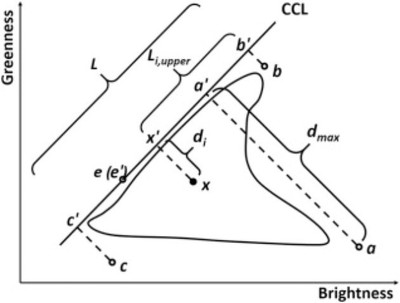
We employ multitemporal remote sensing analysis to infer the net effect of forest conservation policies in Tiantangzhai township, Anhui, China. Our results indicate that between 2002 and 2013, substantial land cover changes took place following the implementation of these two programs compared with the decade before.
During 2002-2013, natural forests increased by 14%, while the area of cropland declined by 9%. This increase in total forest cover likewise resulted in a decline in landscape-wide fragmentation as natural forests received protection and new forest stands were established. CCFP forest stands are located in proximity to managing households and in favorable topographic positions experienced accelerated canopy structural development.
Find more in the book chapter published in Comprehensive Remote Sensing.
Theme 2: Cropland Abandonment
Cropland abandonment has emerged as a common phenomenon in land use transitions, i.e., net forest gain. Ecologically, cropland abandonment and payments for ecosystem services (PES) programs can both facilitate the provision of ecosystem services through reforestation and forest regeneration.
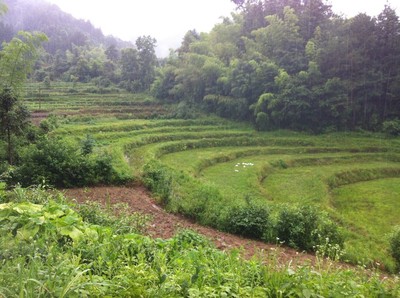
Our findings indicate that:
- Land parcel biophysical characteristics that facilitated cropland abandonment include proximity to EWFP and CCFP forests, poor accessibility, and unfavorable topographic positions, and
- Although CCFP payment did not have a long-term effect on cropland abandonment, a larger amount of EWFP payment significantly increased the likelihood of cropland abandonment.
Find more in the article published in Land Use Policy.
Theme 3: Rural Out-Migration
Labor loss is a major driver of land use decisions by households. We find that CCFP can stimulate rural-to-urban migration by freeing farm labor from land cultivation as it retires cropland in marginal areas for reforestation.
Find more in the article published in Population and Environment.
Theme 4: Household Livelihoods
Positive socioeconomic outcomes of the programs are essential for the long-term success of eco-environment conservation.
We examine income distribution and inequality of rural households under CCFP and EWFP in Tianma Nature Reserve after 12 years of program implementation. Results show that CCFP-participating households have higher income inequality than non-participants, while the EWFP does not have a significant effect. Local off-farm work and out-migration with remittances are the two principal income sources and both add to inequality.
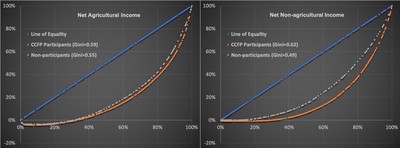
A regression-based decomposition of inequality shows that the CCFP indirectly alters livelihoods by increasing outmigration with remittances, but it also adds to inequality from shifting livelihoods to non-agricultural activities. Meanwhile, EWFP payments positively affect agricultural incomes and contribute 16% to agricultural income inequality. Finally, human capital, natural capital and physical capital all play important roles in generating income and inequality, but the factors affecting inequality from agricultural and non-agricultural activities are different.
Find more in the article published in Ecological Economics.
Theme 5: Pathways from conservation policy to forest sustainability
We integrate household survey data, satellite imagery, and statistical models to identify socioeconomic and ecological pathways from PES programs to forest sustainability through labor migration. The investigation is carried out at two mountainous sites with distinct biophysical and socioeconomic conditions, one in a subtropical mountainous region (Tianma Nature Reserve, Tiantangzhai, Anhui) and the other in the semi-arid Loess Plateau (Ji County, Shanxi).
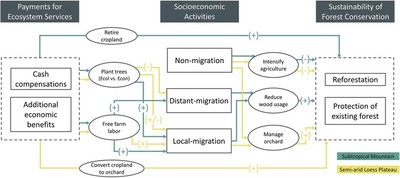
We find divergent CCFP outcomes on migration behavior, stimulating both local- and distant-migration in the Anhui site while discouraging distant-migration in the Shanxi site, after controlling for factors at the individual, household, community and regional levels.
Forest recovery is positively associated with distant-migration in Anhui but with local-migration in Shanxi. Contextual factors interact with demographic-socioeconomic factors to influence household livelihoods in both areas, leading to various socio-ecological pathways from CCFP participation to enhanced forest sustainability. Regional differences should therefore be considered in the design of future large-scale PES programs.
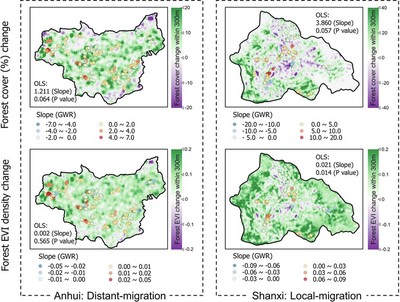
Find more in the article published in Ecosystem Services.
Theme 6: Agent-Based Modeling for CHANS
See details in the project: Modeling coupled human and natural systems with agent-based simulations
Find more in articles
- Zhang et al. 2022a published in Landscape Ecology
- Zhang et al. 2022b published in Anthropocene
Funding sources:
- National Science Foundation, PI: Conghe Song
- Carolina Population Center, PI: Richard Bilsborrow
- American Association of Geographers, PI: Qi Zhang
Related Links:
- News report in UNC Discover: Restoring rural China
- Qi Zhang’s Master’s Thesis: Land use change and forest dynamics under forest conservation policies
- Qi Zhang’s Doctoral Dissertation:
Social-ecological impacts of payments for ecosystem services on land use, migration, and rural livelihoods
Authors: Qi Zhang & Shiqi Tao
Updated: March, 2023